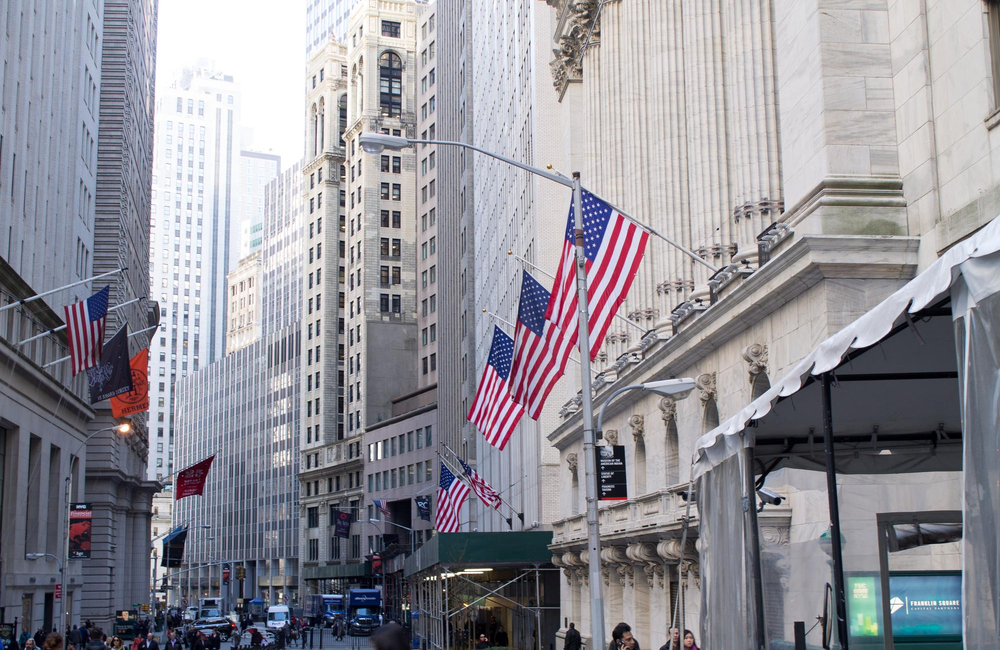ASX futures were 57 points or 0.9% higher at 8:00am AEDT on Monday at 6559, indicating a gain at the opening bell.
The S&P 500 gained 1.9 percent on Friday, ending a five-day losing streak. The benchmark’s advance was led by financial stocks. Citigroup rose 13 percent, State Street gained 9.7 percent and Wells Fargo climbed 6.2 percent. The tech-heavy Nasdaq Composite gained 1.8 percent, and the Dow Jones Industrial Average rose 2.1 percent.
The losses over the week were on all three indexes. The S&P 500 lost 0.9 percent, the Nasdaq was down 1.6 percent and the Dow gave up 0.2 percent for the week.
With a boost from a fresh round of bank earnings and a new report on retail sales that showed the figure had risen more than expected in June, major indexes rallied to end the week. Since more than two-thirds of United States economic activity is bound to household spending, recessions usually come with a pullback by consumers. Still, the Commerce Department reported that Americans’ retail spending had increased 1 percent in June from the previous month, after falling in May.
“You don’t get a recession with 6 million jobs added or consumer spending that isn’t falling,” said Brad McMillan, chief investment officer at Commonwealth Financial Network. “Much of the retail report was just inflation. But on the other hand, sales aren’t falling, either. This doesn't say 'recession.' ”
Banks kicked off the reporting season before the market open, with financial companies, including Citigroup and Wells Fargo, topping estimates and driving the rally in the banking sector. Citi reported stronger-than-expected profit and revenue, but Wells Fargo reported that a slowdown in mortgage lending was a drag on its results. As a group, the financial stocks in the S.&P. 500 rose 3.5%.
In local trade, the S&P/ASX 200 in Australia finished 6605.6, a 0.7% decline, as commodity and financial-sector issues added to a weekly reversal by the benchmark index. The ASX 200 managed to claw back some ground after dropping 1.7% at the open but it still ended down 1.1% for the week.
The materials sector fell 3.2% and contributed eight out of the ASX 200’s 10 worst performers on Friday. Iron ore miners Rio Tinto, BHP and Fortescue all lost between 2.85% and 6.2% as commodity prices eased, as did most lithium and gold stocks.
The wealth manager stocks dragged down the financial sector with them, as banks Westpac, ANZ and Macquarie also slid between 0.2% and 1.8%. Strength in consumer staples and health stocks partly offset weakness elsewhere.
ANZ said before the opening bell on Monday morning that it would purchase Suncorp’s banking operation for $4.9 billion. The bank will tap investors for $3.5 billion in new equity to finance the deal. The deal will require approval by the competition watchdog.
In commodities, Iron ore was down 3.6 percent at $US96.60 a tonne, while Brent crude oil was up 2.1 percent, about 120 points, or 1.16 a barrel, while gold was down 0.1 percent to US$1,703.60.
Across interest rate futures, the probability of a rate cut in the Solomons improved to 22%, but in Australia, the September and December 2019 contracts retreated slightly to 60%. Meanwhile in overseas markets, the yield on 2 Year US Treasury notes edged up to 3.12% and the yield on 10 Year US Treasury notes advanced to 2.92%.
The Australian dollar is 0.6 percent higher at 67.93 US cents at 7:30 am AEST. The WSJ Dollar Index, which measures the U.S. currency against 16 others, declined to 99.82.
Asia
Shares in China finished higher across the board. The benchmark Shanghai Composite Index dipped 0.1 percent to 3281.74, the Shenzhen Composite Index added 0.8 percent to 2192.70 and the ChiNext Price Index rose 2.6 percent to 2819.13. Auto stocks were mixed, with BYD Co. up 4.2%, while SAIC Motor was down 1.1%. Recent data also helped support sentiment, as China’s trade surplus in June soared to $97.94 billion, more than expected and its biggest on record, OCBC analysts wrote in a note. China’s 10.3 percent total trade growth in the first half of 2022 “indicated that China continued to increase its market share of global trade,” they added.
Hong Kong's Hang Seng Index recorded its fifth consecutive losing session as sentiment on the real estate and tech sectors continued to weigh, falling 2.2% to 20297.72. A selloff in property shares extended as Chinese homeowners are refusing to pay mortgages on unfinished homes. Country Garden led laggards with an 8.6% drop, Longfor Group slumped 6.2% and China Overseas Land declined 3.9%. Alibaba Group dropped 6.0% after the WSJ wrote that executives of the company’s cloud division have been listened to regarding the theft of data. BYD Co. was an outlier, up 4.0% following an upbeat profit alert in which it expected first half net profit to more than double from a year earlier. The benchmark index fell 6.6 percent this week.
The Nikkei Stock Average closed up 0.5% at 26788.47, as advances by consumer-discretionary shares, like Fast Retailing, also helped to balance losses in the financial sector. The owner of Uniqlo rose 8.7% after raising its expectations for annual earnings. Dai-ichi Life Holdings declined 3.1% and Mitsubishi UFJ Financial Group lost 2.5% as worries over the global economy outlook mounted on aggressive tightening of monetary policy by major central banks. The broader Topix index finished flat at 1,892.50.
Europe
Stock markets Stocks on Wall Street rise amid stronger-than-forecast US economic data European stocks are higher as US equities firm after US economic data was stronger than anticipated. The pan-European Stoxx Europe 600 rose 1.8 percent, while the German DAX gained 2.8 percent and the French CAC 40 was 2 percent higher. Vitrolife (VITR:SSE) is Stoxx 600’s top gainer, up 15%, after the Swedish producer of IVF products reported strong 1H earnings.
“We’re in another ‘bear market rally’ and a solid one is long overdue,” says IG analyst Chris Beauchamp. Improved US retail sales data could have driven part of this rally, and investors appear to be keen to hunt for bargains following recent drops in equities, he notes.
By Friday, the FTSE 100 had recovered 1.80%, and in a bold return to the arena, adventurous dip buyers braved the waters.
Better-than-expected US retail sales data could have helped to prompt a global bounce-back, Mr Beauchamp says. Still, even if inflation does abate in the coming months, Washington is unlikely to put the brakes on the pace of price increases, and investors should not be under the impression that the summer rally is anything more than a fling, according to Mr. Beauchamp.
North America
U.S. stocks rose on Friday, concluding a volatile week in which investors sought to parse a frenzy of corporate-earnings reports and data that sometimes seemed at odds over the economic outlook.
The major indexes closed the week on a strong note on encouraging bank earnings and data that appeared to show that retail sales had climbed more than expected in June. They fell earlier on a fresh reading that inflation had reached another four-decade high as some of the largest US banks reported disappointing earnings for the quarter.
The S&P 500 gained 1.9 percent on Friday, in its first advance in six sessions. The financial stocks led the advance in the benchmark. Citigroup rose 13 percent, while State Street gained 9.7 percent and Wells Fargo rose 6.2 percent. The tech-heavy Nasdaq Composite gained 1.8 percent, and the Dow Jones Industrial Average rose 2.1 percent.
Each of the three indexes posted weekly losses. For the week, the S&P 500 lost 0.9 percent, the Nasdaq declined 1.6 percent and the Dow fell 0.2 percent.
The market’s whipsawing over the last week could be a signal the 2022 selloff is getting close to a bottom, according to Brad McMillan, Commonwealth Financial Network’s chief investment officer. Stock prices are now more in line with forecast earnings, and many investors are already discounting the effects of higher interest rates, he said.
“We’re in a bottoming process,” Mr. McMillan said. “What you see now is a function of whether you view the earnings data as good or bad. Yesterday was terrible, but you still have expected earnings growth."
The S&P 500 traded recently at 16 times its expected earnings over the next 12 months, compared with 21.5 times at the end of last year, according to FactSet. Analysts expect quarterly profit to have increased 4.2% in the most recent quarter, FactSet data showed.
Investors are grappling with how officials will navigate the desire to rein in inflation versus fears of an economic recession. US consumer inflation rose more than 9.1% in June for the first time in over four decades, stoking traders’ expectations that the Federal Reserve would bolster efforts to curb price pressures by hiking interest rate rises. Yet tighter financial conditions may also be a drag on growth.
Because more than two-thirds of United States economic activity is related to household spending, the pullback by consumers is common in recessions. But the Commerce Department also said that Americans’ retail spending increased in June from the previous month, rising 1%, after falling in May.
“You don’t get a recession with 6 million more jobs being created, with even this consumer spending that is not shrinking,” Mr. McMillan said. “A lot of the retail report was just inflation. But by the same token, sales aren’t down, either. This doesn't say 'recession.' ”
US consumer sentiment flattened out in early July, holding at depressed levels as worries about inflation and an impending economic downturn persisted. A preliminary reading of the consumer sentiment index, released on Friday by the University of Michigan, rose to 51.1 in July, from 50.0 in June -- close to its all-time low.
“Recession risks have increased since the start of the year,” said Mike Bell, global market strategist for J.P. Morgan Asset Management. “Where we are not seeing any signal of consumer retrench, it is maybe not as bad as feared, but when we do see retrench it is a signal that recession risk is materializing.
The rally in the banking sector was ignited following earnings before the market open from the likes of Citigroup and Wells Fargo. Citi reported higher-than-expected profit and revenue, while Wells Fargo said a slowdown in mortgage lending weighed on its results.
State Street also topped Wall Street’s expectations. US Bancorp rose $2.32, or 5.2 percent, to $46.57, and Bank of America gained $2.12, or 7 percent, to $32.25. Financial stocks in the S&P 500 rose 3.5% as a group.
Pinterest stock rose $2.84, or 16 percent, to $20.40. Activist investor Elliott Management has built a big stake in the social-media company, The Wall Street Journal reports. Shares of Vonage Holdings rose $1.33, or 6.8 percent, to $20.98 after the Swedish telecom-equipment giant Ericsson said on Wednesday that it had received approval from the Committee on Foreign Investment in the US for its $6.2 billion bid to buy the company.
UnitedHealth Group gained 5.4 percent, to $529.75 after the company raised its outlook for the second time in two quarters and reported better revenue and profit for the recently ended period.
In the bond markets, the yield on the benchmark 10-year Treasury note dipped to 2.929% from 2.957% on Thursday. Prices and yields move in the opposite direction.
Brent crude, the international benchmark for oil prices, added 2.1 percent to trade at $101.16 a barrel in energy markets.

























